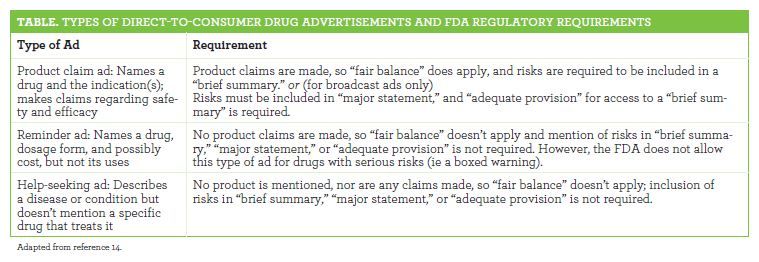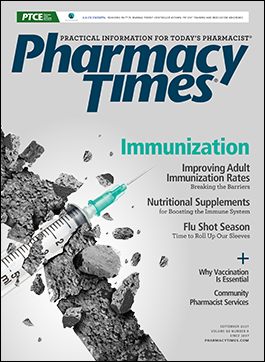Publication
Article
Pharmacy Times
House Bill Takes Aim at Direct-to-Consumer Advertising
Direct-to-consumer advertising is a continuously growing sector of the pharmaceutical industry’s cost expenditure.
Direct-to-consumer advertising (DTCA) is a continuously growing sector of the pharmaceutical industry’s cost expenditure. The United States is one of just 2 countries that allows DTCA, and there are both perceived advantages and disadvantages. Both proponents and opponents have arguments with the level of DTCA regulation by the FDA. Advocates of DTCA say that it increases disease and treatment awareness, while critics are concerned about medication safety and how an advertisement may skew a patient’s perception about the effectiveness of a certain medication or the extent of its risks and benefits.1 Although the future of DTCA is unclear, health care professionals must be educated about publicly aired ads that address the promotion of potentially dangerous drugs and how to best steer the conversation regarding medication risks and benefits to provide the safest and most appropriate care for each patient.
Prior to the 1980s, pharmaceutical manufacturers’ main audience for promotional information consisted of physicians and pharmacists, but the paradigm has shifted. Most this spending (66%) has been allocated to television ads.1 From 1996 to2005, promotional costs for DTCA have increased an average 10.6% a year,2 with a 19% increase from 2014 to 2015 alone, and the spending continues to grow. Estimated 2016 DTCA spending rose to about $6.5 billion, from $6.1 billion in 2015.1 Pharmaceutical companies want to keep an edge with their products, and increased DTCA has been shown to significantly increase sales, with an average $9 return on every dollar spent.3 Eight of the 10 top-selling drugs have at least 1 DTCA ad. The predominant types of drugs that use DTCA are those that are new to the market and those used to treat chronic conditions such as multiple sclerosis and diabetes. In 2016, the diabetes market saw a copious influx of competing products from Boehringer Ingelheim, Eli and Company, and Sanofi, resulting in “defensive ad spending to protect established brands from AstraZeneca and Johnson & Johnson,” according to market research firm Kantar Media, This inundation of DTCA has generated concern about patient safety among health care professionals because of the glorified nature of certain medications whose risks have not yet been adequately discovered in the main population.2
Although DTCA has been controversial, positive impacts such as increased consumer knowledge and concern exist as well in the field of patient and professional health care. First and foremost, DTCA has opened the conversation between patients and health care professionals, thereby providing pharmacists the opportunity to showcase their unique skills as drug expertise. Studies have shown that, though ads state the risks of a medication, the positive impact of the drug may be overstated from the patient’s perspective, and the pharmacist’s job becomes leveling the view to a more realistic depiction of the drug as an option for each patient. Through DTCA, patients are more aware of certain disease states and treatment options, allowing for more open dialogue with health care providers. This new avenue of communication allows pharmacists to provide patients with a more holistic picture of an advertised disease state or a medication’s risks and benefits. Furthermore, such discussions may alert pharmacists to other potential patient health problems, allowing them to recommend the appropriate plan of treatment.3
Even though DTCA has perceived benefits, 2 concerns are insufficient warning about medication risks and ads that make a drug’s benefits look more attractive than they are. According to a study published in the New England Journal of Medicine, 84% of regulatory letters for DTC advertising cited ads for minimizing risks and exaggerating effectiveness. Some examples include omitting adverse effects, making “unsubstantiated claims of superiority over other drugs,” and depicting indications too broadly. For example, Eli Lilly’s Strattera (atomoxetine) was cited for inadequate communication of drug indication for ADHD. Pfizer’s Zoloft (sertraline) was cited for “false or misleading” information due to the omission of the serious adverse effect of suicidality.2 Furthermore, there are concerns about the increased costs to the health care system generated by DTCA. More patients who cite ads as factual knowledge may pressure their doctors into prescribing a specific medication, even if it is not completely necessary or a cheaper alternative exists.3
The FDA is the regulatory body that oversees the approval and marketing of prescription drugs through many statutes and regulations; the Federal, Food, Drug, and Cosmetic Act is the statute that specifically regulates prescription drug advertising. The FDA has established the Office of Prescription Drug Promotion (OPDP) that aims to improve public health by identifying ads that violate the law; educating the industry about ad law specifics; and encouraging enhanced communication between health care professionals and consumers regarding promotional information presented in pharmaceutical ads. FDA regulation 21 C.F.R. §202.1 outlines the requirements for prescription drug ads.4 Although several ad classes and caveats are mentioned, the three main ad types include product claim ads, help-seeking ads, and reminder ads, each with its own requirements and regulation criteria. (Table).5

Recently, Rep. Rosa DeLauro (D-CT) introduced a legislation, the Responsibility in Drug Advertising Act (HR 4565), aimed at restricting DTCA. If passed, this legislation would remove the ability of pharmaceutical manufacturers to deduct the expenditures for DTCA as a business expense to reduce their federal tax liability.
The bulk of DTC-advertised drugs, those for new and chronic conditions, are a major problem because of the immediate release of ads, lack of post-market surveillance time by the FDA, and limited patient exposure, all of which can cause unanticipated drug effects.6 One example occurred with the drug Vioxx (rodecoxib). This medication was approved to treat osteoarthritis pain, but after being released and highly advertised to patients, the medication demonstrated an increased risk of myocardial infarction not previously detected in clinical trials.3 To prevent other such threats, Rep. DeLauro’s bill suggests a three-year moratorium on DTCA for newly approved drugs to allow sufficient population exposure to catch unexpected adverse effects while minimizing total population collateral damage. Furthermore, if a drug is deemed too dangerous by the US Department of Health and Human Services, DTCA can be prohibited altogether. Although this bill has not yet passed, a precedent is set that prescribing should be based on “thoughtful health care decisions by patients and their providers, not by drug marketers,” Rep. DeLauro said.1
Regardless of future regulations, pharmacists remain in a prime position to educate and guide patients to make well-informed and safe health care decisions. With the use of DTCA bypassing health care professionals, pharmacists need to stay informed and be aware of DTCA regulations and legislation to better advise patients.
Noor A. Naffakh is a second-year PharmD candidate at the University of Kentucky College of Pharmacy, in Lexington. Dr. Fink is a professor of pharmacy law and policy and the Kentucky Pharmacists Association Endowed Professor of Leadership at the University of Kentucky College of Pharmacy in Lexington.
References
- Gilchrist A. Bill to restrict DTC ads introduced in house committee. Pharmacy Times®. March 22, 2016. pharmacytimes.com/news/bill-to-restrict-dtc-ads-introduced-in-house-committee. Accessed July 26, 2017.
- Donohue JM, Cevasco M, Rosenthal MB. A decade of direct-to-consumer advertising of prescription drugs. N Engl J Med. 2007.357(7): 673-81.
- Monson, KE, Fink III JL. Direct to consumer advertising, implications for pharmacists and other health professionals. Ann Pharmacother. 2014;48(7):916-918.
- FDA. Background on drug advertising. fda.gov/Drugs/ResourcesForYou/Consumers/PrescriptionDrugAdvertising/ucm071964.htm. Updated June 19, 2015. Accessed July 26, 2017.
- Ventola CL. Direct-to-consumer pharmaceutical advertising: therapeutic or toxic? P T. 2011; 36(10):669-674, 681-684.
- Sullivan T. Senate introduces bill eliminating the tax deduction for DTC advertising. Policy and Medicine. March 16, 2016. policymed.com/2016/03/senate-introduces-bill-eliminating-the-tax-deduction-for-dtc-advertising.html. Accessed July 26, 2017.







